Submarine fault scarps in the Sea of Marmara pull-apart ... - HAL - IRD
Submarine fault scarps in the Sea of Marmara pull-apart ... - HAL - IRD
Submarine fault scarps in the Sea of Marmara pull-apart ... - HAL - IRD
Create successful ePaper yourself
Turn your PDF publications into a flip-book with our unique Google optimized e-Paper software.
Geochemistry<br />
Geophysics<br />
Geosystems G 3<br />
G 3 armijo et al.: sea <strong>of</strong> marmara <strong>pull</strong>-<strong>apart</strong> 10.1029/2004GC000896<br />
however is lack<strong>in</strong>g. It is also generally assumed that<br />
<strong>the</strong> 18th century sequence ruptured entirely this part<br />
<strong>of</strong> <strong>the</strong> NAF and so tectonic load<strong>in</strong>g has been<br />
accumulat<strong>in</strong>g s<strong>in</strong>ce <strong>the</strong>n, unrelieved by significant<br />
rupture <strong>in</strong> <strong>the</strong> north <strong>Marmara</strong> bas<strong>in</strong> [Hubert-Ferrari<br />
et al., 2000; Parsons et al., 2000; Le Pichon et<br />
al., 2003; Parsons, 2004]. This view has been<br />
questioned by Ambraseys and Jackson [2000],<br />
who reassessed possible locations <strong>of</strong> <strong>the</strong> large<br />
historical earthquakes and suggest a much longer<br />
quiescence <strong>in</strong> central and western <strong>Marmara</strong>. Our<br />
direct observations <strong>of</strong> <strong>the</strong> <strong>Sea</strong> <strong>of</strong> <strong>Marmara</strong> floor<br />
allow us to address some <strong>of</strong> <strong>the</strong>se issues, especially<br />
<strong>the</strong> extent <strong>of</strong> submar<strong>in</strong>e rupture <strong>in</strong> 1912.<br />
2.2. MARMARASCARPS Cruise Data:<br />
Key Results<br />
[9] Dur<strong>in</strong>g <strong>the</strong> MARMARASCARPS cruise <strong>the</strong><br />
unmanned submersible ROV Victor 6000 and<br />
<strong>the</strong> oceanographic vessel Atalante were used <strong>in</strong><br />
September-October 2002 to perform a highresolution,<br />
high-precision bathymetric survey<br />
(microbathymetry) <strong>of</strong> <strong>the</strong> ma<strong>in</strong> submar<strong>in</strong>e <strong>fault</strong>s<br />
<strong>in</strong> <strong>the</strong> nor<strong>the</strong>rn <strong>Sea</strong> <strong>of</strong> <strong>Marmara</strong>. The ROV was<br />
operated with a <strong>Sea</strong>bat 8101 multibeam sounder<br />
to survey <strong>fault</strong>s over a total length <strong>of</strong> about<br />
300 km with an average horizontal resolution <strong>of</strong><br />
0.5 m and a vertical accuracy <strong>of</strong> 10 cm, us<strong>in</strong>g a<br />
high-precision submar<strong>in</strong>e navigation system (less<br />
than 10 m <strong>of</strong> uncerta<strong>in</strong>ty) based on a DGPS<br />
position<strong>in</strong>g <strong>of</strong> <strong>the</strong> vessel. Exploration at low<br />
altitude over <strong>the</strong> sea bottom (2 m) was made <strong>in</strong><br />
specific sites to make direct visual observations<br />
<strong>of</strong> <strong>the</strong> <strong>fault</strong> breaks. The ROV landed to sample<br />
35-cm-long cores <strong>in</strong>to <strong>the</strong> disturbed sediment <strong>in</strong> <strong>the</strong><br />
immediate vic<strong>in</strong>ity <strong>of</strong> <strong>scarps</strong>. Samples <strong>of</strong> authigenic<br />
carbonate crusts where also collected near cold<br />
seeps and vents found <strong>of</strong>ten associated with <strong>the</strong><br />
<strong>scarps</strong>. Appropriate projectors and photo/video<br />
cameras were used extensively (key areas are<br />
shown <strong>in</strong> a video supplement that is available as<br />
auxiliary material) 1 . To characterize <strong>the</strong> stratigraphic<br />
environment and <strong>the</strong> sedimentary evolution <strong>of</strong> <strong>the</strong><br />
deep <strong>Marmara</strong> bas<strong>in</strong>s, an extensive survey total<strong>in</strong>g<br />
600 km <strong>of</strong> pr<strong>of</strong>iles with a 3.5 kHz sediment<br />
penetrator across <strong>the</strong> ma<strong>in</strong> deep bas<strong>in</strong>s (Tekirdag<br />
Bas<strong>in</strong>, Central Bas<strong>in</strong> and C<strong>in</strong>arcik Bas<strong>in</strong>) was<br />
undertaken. A complementary sampl<strong>in</strong>g <strong>of</strong> <strong>the</strong><br />
1 Support<strong>in</strong>g material is available via Web browser or via<br />
Anonymous FTP from ftp://ftp.agu.org/apend/’’ (Username = ‘‘anonymous’’,<br />
Password = ‘‘guest’’). Subdirectories <strong>in</strong> <strong>the</strong> ftp site are<br />
arranged by journal and paper number. Information on search<strong>in</strong>g and<br />
submitt<strong>in</strong>g electronic supplements is found at http://www.agu.org/<br />
pubs/esupp_ about.html.<br />
seafloor sedimentary cover close to <strong>the</strong> <strong>fault</strong>s with<br />
a 5-m-long gravity corer was also performed.<br />
[10] For <strong>the</strong> present study we use complementary<br />
data from o<strong>the</strong>r cruises led by a French-Turkish<br />
collaboration program (Program on <strong>the</strong> study <strong>of</strong><br />
seismic hazard <strong>in</strong> Istanbul and <strong>Sea</strong> <strong>of</strong> <strong>Marmara</strong><br />
region). These <strong>in</strong>clude (1) a full coverage <strong>of</strong> <strong>the</strong><br />
north <strong>Marmara</strong> bas<strong>in</strong> with EM300 multibeam bathymetry<br />
(30 m resolution) and side-scan imagery<br />
from cruise MARMARA (performed <strong>in</strong> 2000), and<br />
(2) results from long sediment cores (35 m long)<br />
and calibrated 14 C ages <strong>of</strong> wood fragments from<br />
cruise MARMACORE (performed <strong>in</strong> 2001).<br />
[11] Dur<strong>in</strong>g <strong>the</strong> MARMARASCARPS cruise clear<br />
morphologic evidence <strong>of</strong> recent <strong>fault</strong><strong>in</strong>g activity<br />
was found along several segments <strong>of</strong> <strong>the</strong> nor<strong>the</strong>rn<br />
<strong>Marmara</strong> <strong>fault</strong> system. Along some <strong>of</strong> <strong>the</strong> <strong>fault</strong>s,<br />
f<strong>in</strong>e, outstand<strong>in</strong>gly well-preserved <strong>scarps</strong> were discovered,<br />
probably associated with recent earthquake<br />
breaks. The key results are identified <strong>in</strong><br />
Figure 1: (1) An outstand<strong>in</strong>g break extends <strong>of</strong>fshore<br />
eastward <strong>of</strong> <strong>the</strong> Ganos <strong>fault</strong>, between that<br />
<strong>fault</strong> and <strong>the</strong> Central Bas<strong>in</strong>. (2) A very fresh break<br />
is seen where <strong>the</strong> Izmit <strong>fault</strong> enters westward <strong>in</strong>to<br />
<strong>the</strong> C<strong>in</strong>arcik Bas<strong>in</strong>. It corresponds very probably<br />
to <strong>the</strong> underwater extension <strong>of</strong> <strong>the</strong> 1999 Izmit<br />
earthquake rupture [Çakiret al., 2003; Wright<br />
et al., 2001; Reil<strong>in</strong>ger et al., 2000; Feigl et al.,<br />
2002; Karabulut et al., 2002]. (3) Small fresh<br />
breaks cut along <strong>the</strong> NE edge <strong>of</strong> <strong>the</strong> C<strong>in</strong>arcik Bas<strong>in</strong><br />
over several kilometers. They can be associated<br />
tentatively with <strong>the</strong> Ms 6.4 1963 earthquake<br />
[Ambraseys, 1988; Taymaz et al., 1991]. (4) The<br />
<strong>fault</strong> scarp at <strong>the</strong> SW edge <strong>of</strong> <strong>the</strong> C<strong>in</strong>arcik Bas<strong>in</strong><br />
corresponds to a sharp, steep contact between<br />
bedrock and young sediments. It is seem<strong>in</strong>gly <strong>the</strong><br />
most likely candidate for <strong>the</strong> M 7 1894 earthquake<br />
rupture [Parsons, 2004]. (5) No young break<br />
could be detected between <strong>the</strong> Central Bas<strong>in</strong> and<br />
<strong>the</strong> C<strong>in</strong>arcik Bas<strong>in</strong>.<br />
[12] In <strong>the</strong> follow<strong>in</strong>g sections we present and<br />
discuss selections <strong>of</strong> <strong>the</strong> microbathymetry and <strong>of</strong><br />
<strong>the</strong> 3.5 kHz pr<strong>of</strong>iles, aimed at focus<strong>in</strong>g on <strong>the</strong> set<br />
<strong>of</strong> earthquake <strong>scarps</strong> found <strong>in</strong> western <strong>Marmara</strong><br />
(Figure 2) (A full description and discussion <strong>of</strong> <strong>the</strong><br />
data (microbathymetry, 3.5 kHz pr<strong>of</strong>iles and cores),<br />
particularly on <strong>the</strong> o<strong>the</strong>r <strong>scarps</strong> found dur<strong>in</strong>g <strong>the</strong><br />
MARMARASCARPS cruise, will be purpose <strong>of</strong><br />
future papers by N. Pondard, G. Ucarkus, B.<br />
Mercier de Lép<strong>in</strong>ay, and S. Schmidt)). Those<br />
<strong>scarps</strong> are covered systematically, almost cont<strong>in</strong>uously<br />
with <strong>the</strong> high-resolution data. They cross<br />
three local tectonic environments (transtension,<br />
6<strong>of</strong>29




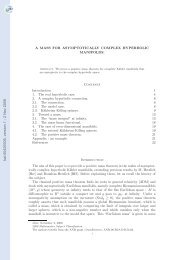
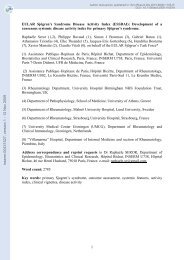
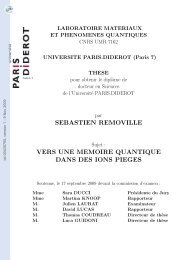
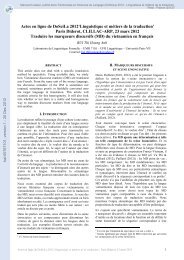
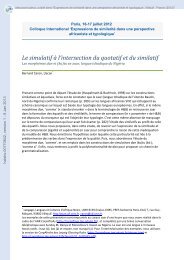
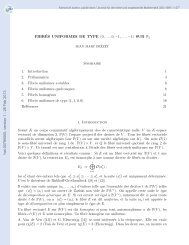
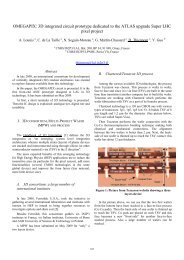
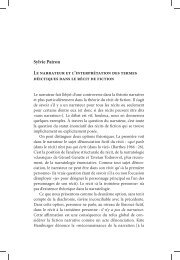
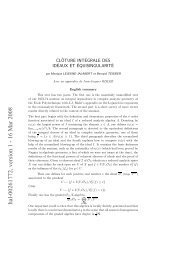
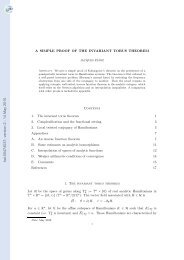

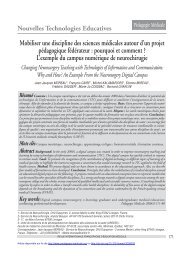

![[tel-00433556, v1] Relation entre Stress Oxydant et Homéostasie ...](https://img.yumpu.com/19233319/1/184x260/tel-00433556-v1-relation-entre-stress-oxydant-et-homeostasie-.jpg?quality=85)